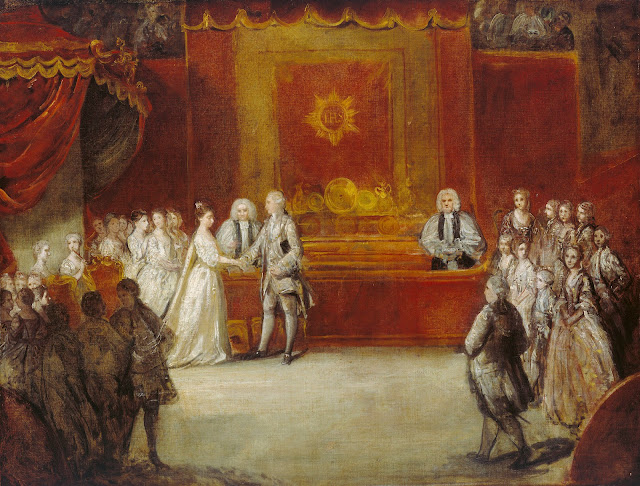 |
| The Marriage of George III 1761 by Joshua Reynolds, 1761. |
“When King George III succeeded to the throne of England upon the death of his grandfather, George II, it was considered right that he should seek some lady in marriage who should fulfil all the duties of her exalted position in a manner to satisfy the feelings of the country at large, and at the same time those of a Prince so ardent an admirer of the fair sex as was George III,” writes Charlotte Papendiek* in her extensive memoirs.
The choice for a bride fell on the 17-year-old Charlotte of
Mecklenburg-Strelitz. The decision was reached primarily because, having been
raised in a small German duchy and being the daughter of the Prince Mirow, the
younger brother of the reigning duke of Mecklenburg-Strelitz, the princess was
thought of as not having the experience or the interest to meddle in politics.
In July 1761, King George III sent for an entourage to
escort his would-be bride from Strelitz to London. The party consisted of the Duchess of Ancaster
and the Duchess of Hamilton, who served as the would-be-bride’s ladies of the bedchamber; Mrs. Tracey, bedchamber woman; Earl Harcourt, proxy for the king ; General
Graeme, to conduct the whole escort ; and Lord Anson, commander of the
squadron. George and Charlotte were
married by proxy, their marriage contract signed by Charlotte’s brother,
Adolphus Frederick IV (who inherited the duchy from uncle Adolphus Frederick
III) and by the Earl Harcourt, representing the king. The people of Strelitz
rejoiced with the union, the festivities running for three days before the bride and her party
departed for London on August 17.
After a stormy crossing of the English channel, the party reached
Harwich on September 7. They rested the night in Witham, at the residence of Lord
Abercorn, and arrived at 3:30 pm the next day at St. James's Palace in London.
On this big day, Papendiek writes:
“They entered London by the suburb of Mile End, and passing through
Whitechapel, which could not have given the strangers a very promising idea of
the beauty or grandeur of the metropolis, or the Princess a very exalted notion
of the people over whom she had come to reign (for that was at that time, as it
is now, one of the most squalid and dirty quarters of London), they continued
along the New Road to Hyde Park, which they crossed, and thence down
Constitution Hill to St. James's Palace, where the King then resided. His
Majesty, surrounded by his brothers, received his bride at the small private
garden gate, in the Friary, and led her through the garden, up the flight of
steps to the Palace.”
The queen, still weary and tired from the long trip, was
married to King George III that very night.
“At about ten o'clock the procession entered the Royal Chapel,” writes
Papendiek. Charlotte was led to the altar by the king’s brothers, the Duke of York
and Prince William, while she was given away by the Duke of Cumberland. Ten
bridesmaids attended her. They were Lady Sarah Lennox, Lady Caroline Eussell, Lady
Caroline Montagu, Lady Harriot Bentinck, Lady Anne Hamilton, Lady Essex Kerr, Lady
Elizabeth Keppel, Lady Louisa Greville, Lady Elizabeth Harcourt, and Lady Susan
Fox- Strangways. Dressed “in Court robes of white and silver,” they bore the
bride’s train “of purple velvet, lined with ermine, the rest of her dress being
of white satin and silver gauze.” The Archbishop of Canterbury officiated the solemn
ceremony.
Horace Walpole later wrote: “The Queen was in white and
silver ; an endless mantle of violet-coloured velvet, lined with ermine, and
attempted to be fastened on her shoulder by a bunch of large pearls, dragged
itself and almost the rest of her clothes half- way down her waist. On her head
was a beautiful little tiara of diamonds ; a diamond necklace, and a stomacher
of diamonds, worth threescore thousand pounds, which she is to wear at the
Coronation, too.”
King George III presented her bride with a fortune’s worth
of gifts, including “a pair of bracelets, consisting of six rows of picked pearls as large
as a full pea ; the clasps — one his picture, the other his hair and cypher,
both set round with diamonds ; necklace with diamond cross ; earrings, and the
additional ornaments of the fashion of the day.” She also gave her “a diamond
hoop ring of a size not to stand higher than the wedding ring, to which it was
to serve as a guard.” Queen Charlotte never adorned the finger where this ring
was snuck with any other ring or jewelry.
When the ceremony ended, the couple proceeded to their apartments. Queen Charlotte, feeling fatigued from the lengthy and strenuous travel, excused herself from attending the
banquet after she and her husband welcomed the guests. Instead, a private supper was served to
the king and queen alone.
Charlotte Papendiek* served, first, an assistant keeper of the queen's wardrobe and later, her reader.
She was the daughter of Friedrich Albert, who was the queen’s page, barber and
hairdresser. In 1783, she married Christopher Papendiek, court musician to King George III. In 1833 Charlotte
Papendiek started writing an extensive set of memoirs, although they were left
unfinished. Her granddaughter, Augusta Anne Arbuthnot, published them in 1887.

.png)





0 Comments